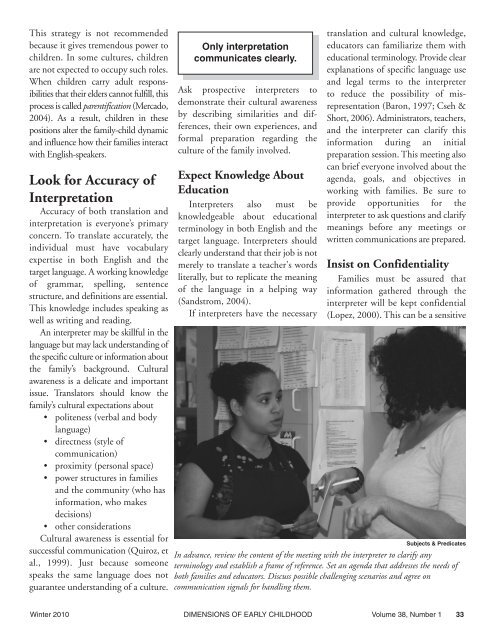90223 Dimensions Winter 10:Layout 1 - Southern Early Childhood ...
90223 Dimensions Winter 10:Layout 1 - Southern Early Childhood ...
90223 Dimensions Winter 10:Layout 1 - Southern Early Childhood ...
You also want an ePaper? Increase the reach of your titles
YUMPU automatically turns print PDFs into web optimized ePapers that Google loves.
This strategy is not recommended<br />
because it gives tremendous power to<br />
children. In some cultures, children<br />
are not expected to occupy such roles.<br />
When children carry adult responsibilities<br />
that their elders cannot fulfill, this<br />
process is called parentification (Mercado,<br />
2004). As a result, children in these<br />
positions alter the family-child dynamic<br />
and influence how their families interact<br />
with English-speakers.<br />
Look for Accuracy of<br />
Interpretation<br />
Accuracy of both translation and<br />
interpretation is everyone’s primary<br />
concern. To translate accurately, the<br />
individual must have vocabulary<br />
expertise in both English and the<br />
target language. A working knowledge<br />
of grammar, spelling, sentence<br />
structure, and definitions are essential.<br />
This knowledge includes speaking as<br />
well as writing and reading.<br />
An interpreter may be skillful in the<br />
language but may lack understanding of<br />
the specific culture or information about<br />
the family’s background. Cultural<br />
awareness is a delicate and important<br />
issue. Translators should know the<br />
family’s cultural expectations about<br />
• politeness (verbal and body<br />
language)<br />
• directness (style of<br />
communication)<br />
• proximity (personal space)<br />
• power structures in families<br />
and the community (who has<br />
information, who makes<br />
decisions)<br />
• other considerations<br />
Cultural awareness is essential for<br />
successful communication (Quiroz, et<br />
al., 1999). Just because someone<br />
speaks the same language does not<br />
guarantee understanding of a culture.<br />
Only interpretation<br />
communicates clearly.<br />
Ask prospective interpreters to<br />
demonstrate their cultural awareness<br />
by describing similarities and differences,<br />
their own experiences, and<br />
formal preparation regarding the<br />
culture of the family involved.<br />
Expect Knowledge About<br />
Education<br />
Interpreters also must be<br />
knowledgeable about educational<br />
terminology in both English and the<br />
target language. Interpreters should<br />
clearly understand that their job is not<br />
merely to translate a teacher's words<br />
literally, but to replicate the meaning<br />
of the language in a helping way<br />
(Sandstrom, 2004).<br />
If interpreters have the necessary<br />
translation and cultural knowledge,<br />
educators can familiarize them with<br />
educational terminology. Provide clear<br />
explanations of specific language use<br />
and legal terms to the interpreter<br />
to reduce the possibility of misrepresentation<br />
(Baron, 1997; Cseh &<br />
Short, 2006). Administrators, teachers,<br />
and the interpreter can clarify this<br />
information during an initial<br />
preparation session. This meeting also<br />
can brief everyone involved about the<br />
agenda, goals, and objectives in<br />
working with families. Be sure to<br />
provide opportunities for the<br />
interpreter to ask questions and clarify<br />
meanings before any meetings or<br />
written communications are prepared.<br />
Insist on Confidentiality<br />
Families must be assured that<br />
information gathered through the<br />
interpreter will be kept confidential<br />
(Lopez, 2000). This can be a sensitive<br />
Subjects & Predicates<br />
In advance, review the content of the meeting with the interpreter to clarify any<br />
terminology and establish a frame of reference. Set an agenda that addresses the needs of<br />
both families and educators. Discuss possible challenging scenarios and agree on<br />
communication signals for handling them.<br />
<strong>Winter</strong> 20<strong>10</strong> DIMENSIONS OF EARLY CHILDHOOD Volume 38, Number 1 33
















